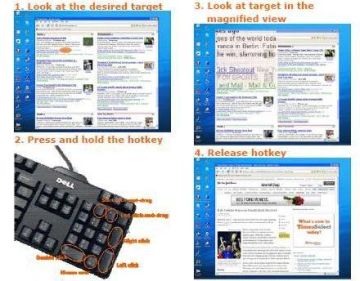Date: Wed Aug 29 2007 - 19:11:41 EDT
August 23rd, 2007
<http://blogs.zdnet.com/emergingtech/?p=671> Using eyes and hands for Web
surfing
Posted by Roland Piquepaille
In a recent article, Computerworld reports that Stanford University computer
scientists have developed a
<http://www.computerworld.com/action/article.do?command=viewArticleTOC&speci
alReportId=9000382&articleId=297900> new way to interact with our computers.
The EyePoint system uses both eye-tracking technology and keyboard hot keys
to reduce our dependency on the mouse while surfing on Internet. The system
is so intuitive to use that the lead researcher said that 'several users
have reported that it often felt like the system was reading their mind.'
With this addition of keyboard interaction, eye tracking might become a
standard computer interface within the next five years, at least according
to the researchers.
Using EyePoint
<http://www.blogsforcompanies.com/TTimages/using_eyepoint.jpg>
EyePoint has been developed by the Human Computer Interface Group
<http://hci.stanford.edu/research/> at Stanford University for its
Gaze-enhanced User Interface <http://hci.stanford.edu/research/GUIDe/>
Design (GUIDe) research project. Manu Kumar
<http://hci.stanford.edu/research/GUIDe/people.html> , a doctoral candidate
in computer science, was the principal researcher for this project, but was
advised by Terry Winograd, a professor of computer science. As you can see
above, "to use EyePoint, the user simply looks at the target on the screen
and presses a hotkey for the desired action - single click, double click,
right click, mouse over, or start click-and-drag. EyePoint displays a
magnified view of the region the user was looking at. The user looks at the
target again in the magnified view and releases the hotkey. (Credit: Manu
Kumar and Terry Winograd, Stanford University)
The short Computerworld article gives additional explanations. "While
looking at a screen, the user presses a hot key on the keyboard, magnifying
the area being viewed. The user then looks at the link within the enlarged
area and releases the hot key, thereby activating the link."
The EyePoint system is only one component of GUIDe
<http://cs.stanford.edu/research/project_spotlights?project=334&page=1>
project. Other components include EyeExpos (for gaze-based application
switching), EyeScroll (which allows users to scroll with their eyes) or
EyePassword (for gaze-based password/pin entry).
The researchers have published many papers about this project. Here are
three papers I recommend if you're interested by the subject.
* EyePoint:
<http://hci.stanford.edu/publications/2007/chi253-kumar.pdf> Practical
Pointing and Selection Using Gaze and Keyboard presented at the 2007
Conference on Human Factors in Computing Systems in San Jose, CA (PDF
format, 10 pages, 1.45 MB)
* Reducing
<http://hci.stanford.edu/research/GUIDe/publications/SOUPS%202007%20-%20Redu
cing%20Shoulder-surfing%20by%20Using%20Gaze-based%20Password%20Entry.pdf>
Shoulder-surfing by Using Gaze-based Password-entry presented during the
2007 Symposium on Usable Privacy and Security in Pittsburgh (PDF format, 7
pages, 3.32 MB)
* GUIDe:
<http://hci.stanford.edu/publications/2007/inter137-kumar.pdf> Gaze-enhanced
UI Design (PDF format, 6 pages, 267 KB) [Note: the illustration above has
been extracted from this document.]
Sources: Drew Robb, Computerworld, August 20, 2007; and various websites
You'll find related stories by following the links below.
* Computers <http://del.icio.us/rpiquepa/Computers>
* Human <http://del.icio.us/rpiquepa/HumanComputerInterface> Computer
Interface
* Innovation <http://del.icio.us/rpiquepa/Innovation>
* Security <http://del.icio.us/rpiquepa/Security>
* Software <http://del.icio.us/rpiquepa/Software>
* Vision and <http://del.icio.us/rpiquepa/Vision> Visualization
http://blogs.zdnet.com/emergingtech/?p=671
